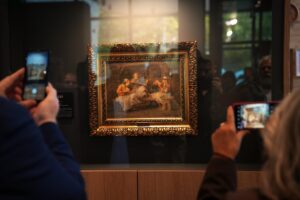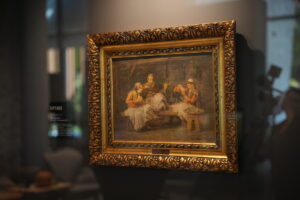A masterpiece of world painting, hidden from the public eye for decades as part of private collections, has now shone in full color and blended beautifully with the idyllic autumn landscape of Mount Rtanj.

Paja Jovanović’s painting The Card Players was ceremoniously unveiled today at the Ramonda Hotel, and this historic acquisition represents far more than a mere purchase of an artwork—it is a true act of cultural patriotism.
The painting, previously unknown to the public, could have easily found its way into the hands of wealthy collectors abroad, but the Ramonda Hotel emphasized that their primary motivation was to ensure this national treasure remained in Serbia. This is particularly meaningful given that the hotel, with its collection of 300 paintings, a library of more than 3,000 titles, and a rich cultural program, has already become one of the key pillars of Serbia’s cultural life.
“Ramonda is a hotel, but above all, it is one big family. We are creating something entirely authentic—a space for the soul and the body. What makes us special is that we’ve become ambassadors of Serbia, and especially of Eastern Serbia. The painting came into our hands quite by accident. The Stepanović family loves art. They were invited to help find a buyer abroad, but when they saw the painting, they fell in love with it and realized it should become part of their family collection. That’s how it arrived at our hotel. All our guests, as well as those who just stop by for a coffee, can now enjoy this masterpiece,” said Tijana Šipka, Sales and Marketing Manager at the Ramonda Hotel.

A major cultural event for the region
Paja Jovanović was one of the greatest Serbian painters, a key figure in the era of Realism and in preserving Serbian identity. The acquisition of his painting The Card Players is a shining example of how national heritage can be preserved and how a deep, unbreakable connection can be forged between the Serbian people and a work of art.
“This painting was created in 1934. Chronologically, it belongs to Jovanović’s later period, when he primarily painted portraits, but in terms of subject matter and genre, it recalls his earlier phase, when he often depicted genre scenes—which can be confusing to some. He was a painter who lived for an entire century and left behind an enormous opus of over 1,100 works spanning a wide range of genres, motifs, and themes.
His art should never be viewed in a linear way. This painting depicts male figures engaged in a typical male ritual—moments of leisure and relaxation—as they sit in a tavern playing cards. So, Jovanović thematically returns to where he began. He was an artist who created at the height of fame, yet remained unburdened by it. It’s no surprise, then, that in his later years he revisited these subjects,” explained Marija Simonović, art historian, who congratulated the hotel management on their outstanding collection and on welcoming such an important artwork into their care.
She concluded by emphasizing that this was “a major cultural event for the entire region.” Speaking on behalf of the Stepanović family, Aleksa Stepanović thanked the guests, wished them to always feel at home at Ramonda, and ceremoniously unveiled the painting, which will now occupy a central place in the hotel—and on Serbia’s cultural map.
